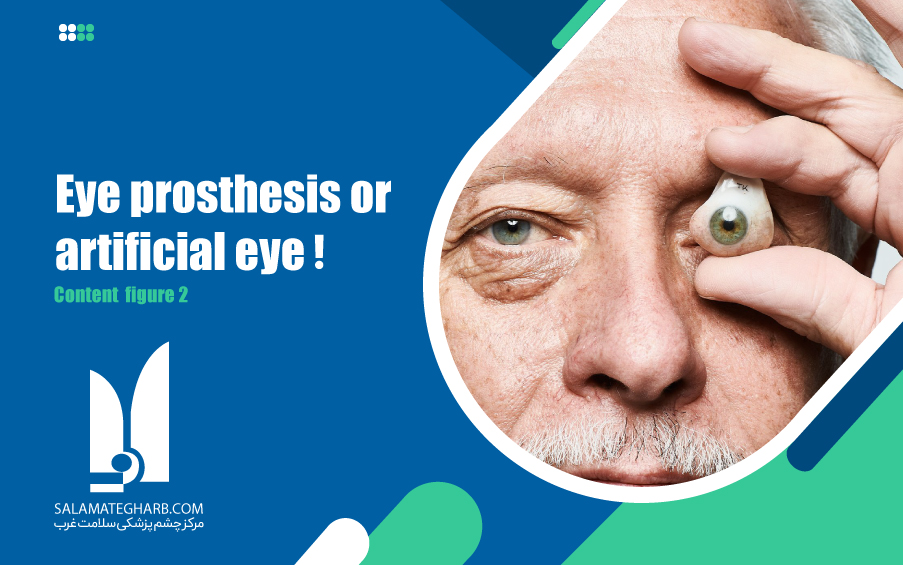Artificial eye ingredients
In the past, glass eyes were actually made of glass. Today, a prosthetic eye is generally made of hard, plastic acrylic. The artificial eye is shaped like a shell.
The artificial eye is placed on an eye implant. An eye implant is a hard, separate device that is surgically and permanently implanted in the eyeball.
Eye implants are often covered with living tissue or a synthetic enhancer before placement.
How is an artificial eye made?
About 6 to 8 weeks after eye resection surgery, when the swelling is sufficiently reduced and suitable for measuring tissue, the ophthalmologist measures the size of the eyeball to make the right prosthesis of the same size. To improve the natural appearance of the artificial eye, the iris and the white part of the eye are usually painted by hand, and sometimes digital printing is used. So your new eye is indistinguishable from a healthy eye, except that it does not move completely like the other eye, and its pupil does not change in response to light. It usually takes four sessions to prepare an artificial eye. The eye can be completed in one to two weeks, depending on the schedule.
Polishing artificial eyes
Professional polishing creates a more natural comfort and appearance, and removes scratches, protein deposits and bacteria from the surface of the prosthesis. An examination will also be done to make sure your tissue is healthy and the prosthesis is in place. In this session, the doctor also examines the eyeball to make sure the tissue is healthy and the prosthesis is positioned correctly. The prosthesis should be professionally polished every six months.
Some of the symptoms that may occur when polishing is needed are:
Irritable or itchy eyelids
Increased dehydration or eye discomfort
• Change in appearance
Useful tips for users of artificial eyes
Practical tips for using artificial eyes include:
• Always clean your hands when handling dentures.
Examine your surroundings to make sure the prosthesis is not damaged or lost if it accidentally falls.
Excessive handling can irritate and secrete too much water. Only remove the prosthesis as directed by your doctor.
Always close your eyelids and pull towards your nose to clean, wiping out may remove the prosthesis.
• Try to point your chin at the person you are talking to. Practice moving your head and shoulders as you speak, not just your eyes.
Goggles with polycarbonate lenses help protect the natural eye.
• Keep your artificial eye in a tissue, as it may be accidentally discarded.
Do not clean the prosthesis with any solvent, hand sanitizer or alcohol, as these chemicals may damage the prosthesis and your eyeball.
Artificial eye lubricants
Artificial eye users may sometimes have dryness, burning, and difficulty blinking. Unfavorable weather, dust, wind and air conditioning usually cause moisture to evaporate from the front of the prosthesis. Allergies and changes in the body can also play a role in dryness.
To apply a lubricant or eye drop to your prosthesis, apply a drop on a clean finger and rub it on the prosthesis. Blink a few times, then close your eyes and dry your skin with a paper towel to remove any excess material. Silicone lubricants can be used if needed, which can initially be used in the morning and evening. Water-based eye drops can also be used every 2 to 3 hours if needed.
How is the artificial eye held in place?
The artificial eye is held in place by the eyelids, with proper placement on the back of the prosthesis.
What should be the interval between cleaning the prosthesis?
Contrary to popular belief, prostheses usually do not need to be cleaned daily or removed at night. Your ophthalmologist will give you tips on how to clean your prosthesis and how often to polish it. When removing the prosthesis for cleaning, remember to place it in the eye socket as soon as possible to protect this area.
How long does the artificial eye last?
Typically, an artificial eye takes about 5 years to replace. Tissue changes in the eyeball, anatomical growth, and acrylic breakdown are the main reasons for its replacement. Due to growth mutations, prostheses in children after 3 to 4 years should be replaced.
Does the artificial eye move with the natural eye?
In most cases, your prosthetic eye is moving. The amount of artificial eye movements depends on several factors, such as preoperative conditions and postoperative recovery. The ophthalmologist inserts the eyeball with an orbital implant during surgery to transfer the maximum possible displacement to the prosthesis. The ophthalmologist also attaches the prosthesis to the orbital implant to allow maximum displacement.
Is it possible to exercise while using artificial eyes?
The use of artificial eyes will not prevent you from exercising in most sports. However, if possible, exercise goggles should be worn. Especially when swimming, during which you should always wear swimming goggles.


Leave A Comment